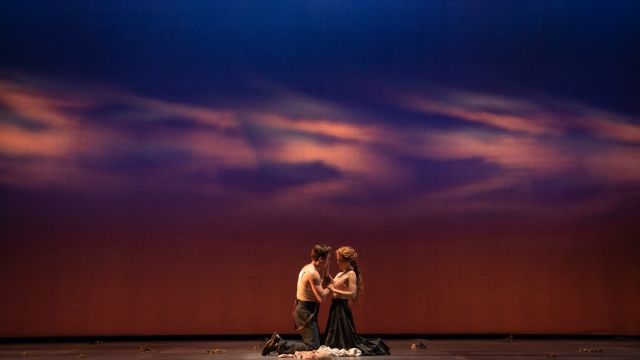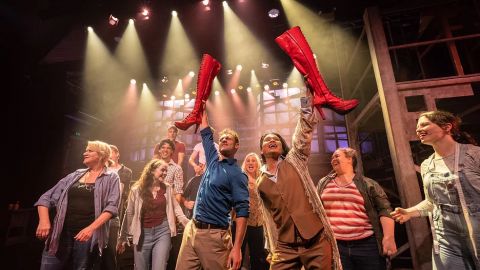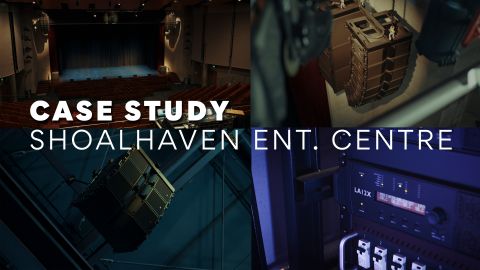Playing with Light

Multi-award-winning Nick Schlieper talks to Martin Portus about the rigour and magic of lighting our landmark operas, plays and dance works for four decades.
Nineteen-year-old Nick Schlieper first plugged into his craft alone backstage at Doris Fitton’s old Independent Theatre in North Sydney in 1977.
It was a time in Australian theatre when the lighting guy was usually one of the mechs. Nick was the Independent’s resident stage manager; restless, he began experimenting every night during the show by shifting around the lights. Actors learnt to just work around it.
Schlieper has been playing with light ever since, earning – and demanding – a respect for the precision, invention and storytelling role of his craft, and his very distinctive signature in lights.
It’s no surprise that painters are his first inspiration – think Turner and Edward Hopper and Nick’s own late brother. Michael Schlieper, Nick’s senior by 11 years, would work on his canvases through the night at the family home in Chatswood. Every morning, getting ready for school, Nick would observe the added layers, the depths appearing from new light and colours.
 “I think I learnt most about lighting design and light from that exposure, watching him painting and then, growing up, talking to him about it, and watching his style change radically over a few decades,” says Nick. (Michael and Nick Schlieper pictured, right.)
“I think I learnt most about lighting design and light from that exposure, watching him painting and then, growing up, talking to him about it, and watching his style change radically over a few decades,” says Nick. (Michael and Nick Schlieper pictured, right.)
“He started out as a wildly abstract painter, went through a very figurative, so-called Teutonic, social commentary period and then ended up painting landscapes but with a great facility for technique, which I learnt from him.”
Nick’s start in stage management also added a practical insight into the logistics of theatre – and the required diplomacy. He was soon responsible for casts and crews far older than he, calling shows, later operas, with the big companies in Sydney, Brisbane and Adelaide. Finally as a production manager, young Schlieper always had work …until, that is, he put out his shingle as a freelance lighting designer.
The jobs were few but, somehow, he scored the lighting gig on the STC’s Summer of the Seventh Doll and Away, both of which went to New York in 1988. He remembers Roger Kemp’s three model houses signifying the three families intersecting in Away.
“It was played in tight areas and was the first time I had to create a naturalistic pool of light in an abstracted stylised space yet evoking a sense of place. And I approached it from an incredibly simple point of view – of standing under a light bulb, but expanded.”
German director Harald Clemen commissioned Nick to light a show at the prestigious Schillertheater/ Berlin just before the Wall came down was, he says, like “dancing on a volcano ” with the arts integral to everyone’s fervent conversation, and part of the arsenal between East and West.

Image: Nick at the lighting desk for Love Never Dies in 2012. Photographer: Jeff Busby.
“And at the theatres I suddenly understood where my aesthetic had come from, it was like coming home,” says Nick, whose family immigrated from Germany.
“In Australia I was jokingly criticised for my work being very Teutonic, very stark, without much colour. I spent a lot of time making people look right, not nice - which is not the same thing. I do use very steep angles, very cold light, all things very unfashionable then.”

Home he may be, but Nick was also staggered at the absence in Germany of expressive techniques in lighting design. Images of German theatre may look stunning, but the lighting was fixed.
The idea of leading the audience’s eye, lighting the actor and expanding on the emotion was becoming essential to Nick’s story-telling toolkit back in Australia but, then at least, it was foreign in Germany.
“Germans called it dramaturgical lighting, and actors even said to me that they resented me doing their job for them. It was best to do it under fluoros and with the house lights on! It was a Brechtian hangover.”
Times have changed. Nick went on to work regularly across Germany, and notably at the Salzburg Festival: he’s just returned from there, lighting a brilliantly urbane contemporary version of Médée. For more than a decade he’s taught lighting design in Munich and he went on to see WAAPA in Perth establish Australia’s one major lighting course.
But ‘dramaturgical’ remains his best descriptor. He rejects all jobs unless he’s included from the start in that first collaborative planning with the director and other designers. He reads the script or score over and over again and, he says, he eschews tricks and focuses his lights only on advancing the meaning of the work.
“We start with that simple question – why are we doing this work? It’s all the more vital a question when it’s a classic. I’ve done five productions of Macbeth; if you don’t ask why you’re doing it here at this time and place, then they’d all look the same. And once you answer that question, you find the environment in which you’ll do it.”
All this was well tested when Nick and his frequent collaborators, director Elke Neidhardt, set and costume designers Michael Scott Mitchell and Stephen Curtis, started planning what was Australia’s first full production of Wagner’s Ring Cycle. It was premiered by the modest sized State Opera Company of SA in 2004, but years earlier Nick was getting his head around a score lasting 16 and a half hours.

And it was all the harder, given his block about Wagner, one he suggests is common in many Germans.
“It just makes me very uncomfortable, to the base of my spine, since it’s so laden with his vile thoughts…. so learning what I find fairly repugnant music was a challenge.”
Still, five years out, he joined the creative team, all of them leaving behind their phones and locking themselves away in a Blue Mountains retreat.
“But at the end of that week at “Camp Wagner”, we’d only got as far as the first five minutes of the first opera, and most of that was the prelude!
“Still, all that time we were addressing the whole framework with the same question, why are we doing this work yet again and why in Adelaide?”
This landmark Ring had massive, strikingly lit set pieces, but here again for the lighting designer the priority was story-telling, of not losing sight of the human stories over time.
“We always made sure that after fabulous visuals we came back to a permeable box with no scenery in it, just lots of light and that light in those interludes, even more than usual, with a focus all about the singers.”

With a set that filled 38 shipping containers (an average opera may fill three) and a lighting rig with a thousand lamps, this was the biggest theatre show ever staged in the country. Oddly for the celebrated designers, the job offers then dried up.
“You’re so easily pigeon-holed by this industry. I think we were both branded as, they only do huge now!”
Nick however did join another trusted collaborator, director Simon Phillips, in 2006 to create the stage version of the film hit, Priscilla, Queen of the Desert.
“I’m not drawn to musicals but I was keen to get over my prejudice that they’re all flash and giggle and not much craft.”
With a colour palette beginning with hot pink, he was also repainting his reputation as a master of stark white light. Nick’s starting point with Priscilla was that every scene have the sparkle, the heightened colours, as though viewed through the lens of a drag show – just like back then at the famed Imperial Hotel in Newtown, Sydney. He admits that the lighting took a leap elsewhere, especially with the introduction of Brian Thomson’s magically inventive bus and a huge tech budget. And Nick finished up with a lighting plot of 2,500 cues.
The arc of Nick Schlieper’s career has seen an ever-growing respect – from audiences, critics and industry colleagues – for the craft of a lighting designer, and an astonishing shift in the technology at their fingertips.

“I’ve seen manually operated desks replaced by computer boards; football-sized globes replaced by ones golfball-sized; and colour temperature and heat emissions have changed so much we can have an expanded palette of colour gels. And importantly we can now have a whiter, less yellow light.
“At first with computers doing a lighting fade we missed the skill of a good operator, but now these have a control which is incredibly sensitive. You can virtually move a host of lights throughout a show without the audience being aware of what you’re doing.”
A negative for Nick is LED technology. He argues it reduces the colour ring spectrum to just 70%; with the missing 30% so critical because that’s the light most sympathetic to skin tones, to lighting the actors and telling the story.
It didn’t stop him, however, employing a huge back wall of white light in the STC’s Cat on a Hot Tin Roof. The lighting bank initially simmered and then blasted direct into the audience, suggesting the fireworks – and raw emotions – that climaxed at the end of the play.
Nick has the perfect collaborator in STC artistic director Kip Williams, whose own stage signature often strips everything to an empty space, often with a revolve, defined with little set or clutter, and so often dramatised by cross lighting.
 Their recent credits also include Chinamerica, with its complex storytelling across countries and decades; the epic dramatisation of Ruth Park’s Harp in the South; Brecht’s Arturo Uri with Hugo Weaving; White’s ghoulishly vaudevillian A Cheery Soul; and Shaw’s St Joan. He just finished lighting Simon Phillips’ STC production of Stoppard’s The Real Thing.
Their recent credits also include Chinamerica, with its complex storytelling across countries and decades; the epic dramatisation of Ruth Park’s Harp in the South; Brecht’s Arturo Uri with Hugo Weaving; White’s ghoulishly vaudevillian A Cheery Soul; and Shaw’s St Joan. He just finished lighting Simon Phillips’ STC production of Stoppard’s The Real Thing.
He remains a big fan of white light and cross-lighting, and his reasoning, of course, comes back to what’s true to the performers.
“It solves the age-old problem of people standing next to each other talking as we do in real life, by lighting along the axis they’re speaking to each other.
“And it gives such a sculptural impact to dancers. It makes bodies look fantastic and faces so much more interesting and more present.”
Nick has lit six notable shows by Bangarra. With Patyegarang and the most recent, Bennelong, he’s lit Stephen Page’s significant shift to a dance theatre storytelling involving points of view both indigenous and colonial.
 “In terms of the practical, it’s about being very careful about colour and choosing the optimum angle for dancers … but with the episodic story of Bennelong I also had to be wary about leaving the audience with a clear dramatic structure.”
“In terms of the practical, it’s about being very careful about colour and choosing the optimum angle for dancers … but with the episodic story of Bennelong I also had to be wary about leaving the audience with a clear dramatic structure.”
He’s getting over being what he describes as “the whitest thing possible in that context, yes Aryan even!
“It’s a very useful reminder – as if its needed – of how strongly you can feel being the ‘other’, and useful to have the boot on the other foot.”
Nick Schlieper spoke to Martin Portus for a State Library of NSW oral history project on leaders in the performing arts; the full interview is now available on the Library’s website.
Production images (from top): The Harp in the South - STC (photographer - Daniel Boud); Saint Joan - STC (photographer - Brett Boardman); North by Northwest - MTC (photographer - Jeff Busby), 2 images from Bennelong - Bangarra; 2 images of The Ring Cycle (2006).





